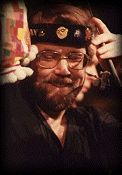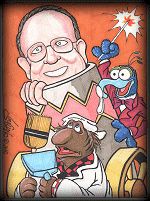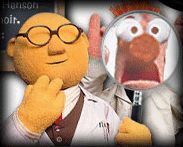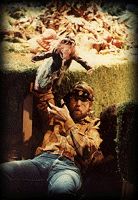| A
R T I C L E S |
New Collectibles •05/25 - NECA Sesame Street: Count Von Count Ultimate Action Figure
•04/25 - Reaction Sesame Street: Big Bird and Snuffy •03/25 - NECA Sesame Street: Ernie Ultimate Action Figure, Bert Ultimate Action Figure
•03/25 - Boss Studios Fraggle Rock: Boober Action Figure, Wembley Action Figure, Mokey Action Figure, Sprocket Action Figure •08/24 - Reaction Sesame Street: Big Bird, Mr. Hooper, Sherlock Hemlock, Super Grover |
||
|
|
|

Gonzo
Puppeterism:
An Interview with Muppeteer Dave Goelz
By
Kenneth Plume
January 28, 2000
Sequestered in a small but cozy dressing room within Screen Gems Studios in North Carolina in the middle of January of 1999, I sat down for a talk with Muppeteer Dave Goelz. As carpenters and set builders hammered together Noah's Ark a few yards from where we sat, Dave and I talked about his background, work, and thoughts on his career.
![]()
First of all, tell me a little bit about your background...
 |
| Dave Goelz performs on the set of Fraggle Rock. |
GOELZ: I have always enjoyed puppets, but at two times during my childhood puppetry became a hobby. When I was five I became a huge fan of Howdy Doody, and when I saw a Howdy dummy at the local toy store, I got very excited. My folks said that if I saved half the money, they would match my funds and I could get the dummy, which I believe cost either $3.95 or $7.95. I saved every penny of my 25 cents per week allowance, and in no time my parents were surprised that I was ready to make the purchase. The next Christmas my parents gave me a Howdy Doody marionette. During this period I was also interested in the original "Time for Beany" puppet show, starring Stan Freberg and Bob Clampett. I had Beany and Dishonest John hand puppets made by Ideal Toys, but was disappointed by the official rubbery Cecil the Seasick Sea Serpent puppet. My mother made a beautiful Cecil for me completely from scratch. She was a big influence; she showed that you could make whatever you needed.
When I was thirteen, I became interested in marionettes. In junior high school I had become fascinated by the theater, with its curtains and colored lighting. My father built a marionette stage for me, and I equipped it with three strings of our Christmas lights; one whole string in blue, one in red, and the other in yellow. That way we could plug in different strings to make a range of colors. My friend Eddie Paul and I wrote scripts and put on marionette shows for our family and friends. I had a little printing press and we made tickets for the shows, for which we charged ten cents. We made well over a dollar in less than a month, easy money.
After high school I studied to be an industrial designer, and entered the profession. After a couple of years I started watching Sesame Street on Saturday mornings and just got hooked. I had been a Muppet fan for many years, but now I started getting fascinated with the design process that went into what I was seeing on the screen. Who were these people who created the puppets, costumes and performances that were so evocative? I got very curious.
 One
day, I read in a newspaper and read that Frank Oz was to appear nearby
at a puppetry festival, so I took a day of vacation time and went to see
him. I was just blown away by the two shows Frank did at Mills College
in Oakland. During the first show, I was like an assassin. I was in a
window above and to the side of the stage with a telephoto lens and a
couple of rolls of film. It was fascinating to see Frank working. During
the second show - they had to give two shows since so many people came
- I sat out in the audience. I could feel the love for those characters
all around me. After the show, I got up to go back home and back to my
job of designing these boxes for scientific instruments. As I trudged
to the car amidst a buzzing crowd, I had a strong feeling that I should
be doing puppetry, but I had no idea how I could make a living at it.
I didn't think there was any potential at all, so I was just sad. Within
about a month of that day I was asked to make a business trip, which was
a very rare event. Not only that, it took me to Pennsylvania. At the end
of my work, I took a week of vacation time and went to New York and visited
Sesame Street. How odd that my whole career grew out of six days of vacation
time? I went to Sesame Street every day and just watched them work.
One
day, I read in a newspaper and read that Frank Oz was to appear nearby
at a puppetry festival, so I took a day of vacation time and went to see
him. I was just blown away by the two shows Frank did at Mills College
in Oakland. During the first show, I was like an assassin. I was in a
window above and to the side of the stage with a telephoto lens and a
couple of rolls of film. It was fascinating to see Frank working. During
the second show - they had to give two shows since so many people came
- I sat out in the audience. I could feel the love for those characters
all around me. After the show, I got up to go back home and back to my
job of designing these boxes for scientific instruments. As I trudged
to the car amidst a buzzing crowd, I had a strong feeling that I should
be doing puppetry, but I had no idea how I could make a living at it.
I didn't think there was any potential at all, so I was just sad. Within
about a month of that day I was asked to make a business trip, which was
a very rare event. Not only that, it took me to Pennsylvania. At the end
of my work, I took a week of vacation time and went to New York and visited
Sesame Street. How odd that my whole career grew out of six days of vacation
time? I went to Sesame Street every day and just watched them work.
Was the set more open then as opposed to now?
 |
| Dave Goelz's Bunsen along with Steve Whitmire's Beaker are one of the most famous Muppet duos. |
GOELZ: At that time Sesame Street was shot at Teletape Studios at 81st & Broadway. I had pre-arranged with Frank Oz to visit the set. This was the fall of 1972. I watched them shoot for the entire week and they were all very kind to me. I had brought some puppets with me that I had made, and the Muppet people there said, "You should show these to Bonnie Erickson, head of the Muppet Workshop".
So I phoned Bonnie and went across town to visit her. When I showed her my puppets, she said, "Oh that's great! You can build puppets. You should meet Jim, but he's in France right now." About a month after that, I was sitting at my desk in California and the phone rang and this voice said, "Hi there. This is Jim Henson." I went, "WHAA?!?" He sounded like Ernie! I jumped up and looked over the partitions around the lab. Everyone was just working normally, and I had Jim Henson on the phone! I could not believe it. He suggested that we meet in Los Angeles the following week when he was scheduled to appear on a Perry Como special. So we met in Los Angeles, and I showed him my portfolio. It was an industrial design portfolio that covered my career. It went something like this: John Deere tractor, American Airlines interior, Hewlett Packard laser interferometer -- puppet. I told him my objective was to illustrate how my background was perfect for becoming a puppet designer. In fact, it was.
We agreed to stay in touch. I planned to borrow some video equipment and start performing in my own videotapes. In about a month or two I got another call from Jim saying, "I'm coming to San Francisco would you like to get together?" So I booked a hotel for him in Los Gatos. I took him out to dinner and when I picked him up he was waiting outside, a tall, gaunt figure standing in the rain. He looked frail and vulnerable. Later I would learn just how strong he really was. After dinner I showed him the tapes that I had just completed. This was around February of 1973, and he was contemplating doing a Broadway stage play that utilized many forms of puppetry. He asked me if I would be interested in being involved both as a designer and a performer. We stayed in touch and by June we worked out a deal where I came to work for six months on the designing and building phase of that project. During my stint, Muppets got a series pilot with ABC, so we put the stage play aside and worked on the pilot. Jim asked me to perform three characters in the show, so I stayed an extra couple of weeks for the shoot. Jim invited me to join the company, but I didn't feel at home in New York, so I went back to California.
 |
| Dave Goelz performs Philo, one of the associates of the all-knowing Trash Heap. |
I had been on a leave of absence from my electronics job, and during the extra two weeks that I stayed in New York, I was replaced. I realized this was a good thing, because I had been afraid that I'd go back to work, get comfortable and secure and never pursue this work that I was passionate about. After a few weeks I started my own business doing industrial advertising and videotape work using puppets. Soon I had a couple of clients and was doing good business. After about 8 months, Jim made me an offer that I couldn't really refuse. Jim proposed that I keep my main industrial client, come to the Muppet Workshop as a designer/builder, and perform occasionally in specials. It gave me the Muppet work that I was passionate about and included several escapes to California each year. This was an example of Jim's business genius. He knew I didn't like New York, so he conceived of a deal whereby I would get to leave frequently to service my client. How could I say no? So I did it.
|
|
|
home | news | collectibles | articles | forum | guides | radio | cards | help
Fan site Muppet Central created by Phillip Chapman. Updates by Muppet
Central Staff. All Muppets, Bear
Muppet Central exists to unite fans of the Muppets around the world. |